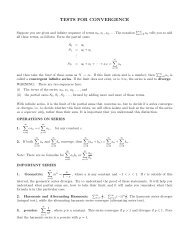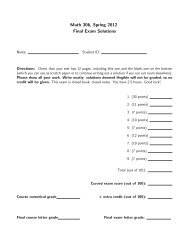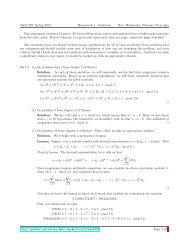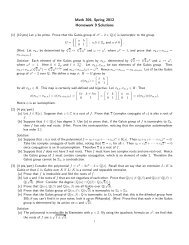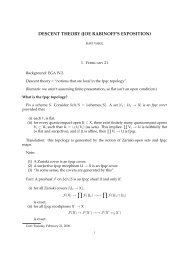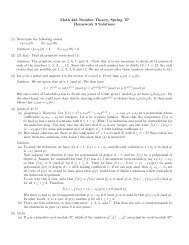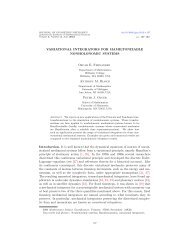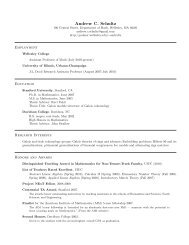Math 223 Number Theory, Spring '07 Homework 2, due Friday ...
Math 223 Number Theory, Spring '07 Homework 2, due Friday ...
Math 223 Number Theory, Spring '07 Homework 2, due Friday ...
You also want an ePaper? Increase the reach of your titles
YUMPU automatically turns print PDFs into web optimized ePapers that Google loves.
p q r q ∧ r p ⇒ (q ∧ r)T T T T TT T F F FT F T F FT F F F FF T T T TF T F F TF F T F TF F F F T(4) Translate these statements into English, with x and y representing real numbers. Arethe statements true?(a) ∀x∃y (x < y)(b) ∃y∀x (x < y)(c) ∀x∀y∃z (xy = z)Solution:(a) For every x there exists a y such that x is less than y. This is true: given an x,choose any y that is bigger.(b) There exists a y such that, for every x, x is less than y. This is not true: thereis no greatest number y.(c) For every x and for every y, there exists a z such that z is the product of x andy. This is true: choose z to be the product xy.(5) Let F (x, y) be the statement “x can fool y”, where the domain is all people. Usequantifiers to express each of the following.(a) Everybody can fool Fred.(b) John can fool everybody.(c) Everybody can fool somebody.(d) There is noone who can fool everybody.(e) Everyone can be fooled by somebody.(f) Noone can fool both Fred and John.(g) Mary can fool exactly two people.(h) There is exactly one person whom everybody can fool.(i) Noone can fool himself or herself.Solution: Note that there are more than one equivalent ways to say some of thesestatements, especially ones involving negation since the negation can be placed beforeor after quantifiers, distributed according to deMorgan’s laws, etc.(a) ∀x F (x, Fred)(b) ∀y F (John, y)(c) ∀x∃y F (x, y)(d) ¬∃x∀y F (x, y)(e) ∀y∃x F (x, y)(f) ¬∃x (F (x, Fred) ∧ F (x, John))(g) ∃x∃z [((x ≠ z) ∧ F (Mary, x) ∧ F (Mary, z)) ∧ ∀y ((y ≠ x ∧ y ≠ z) =⇒ ¬F (Mary, y))]



